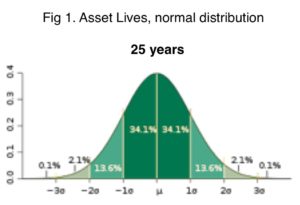 In our current data driven environment, there is still a role for common sense
In our current data driven environment, there is still a role for common sense
A few years ago, using its renewal model, a council was advised that its buildings were 60% overdue for replacement. This came as a great surprise to the Council – but should it have? If true, one would have imagined that there would be many visible signs of major deterioration – non-habitable buildings boarded up for safety, signs of breakdown in buildings still in use (e.g. lifts, plumbing or HVAC not working), union demonstrations, protest movements, etc. If true, this should not have been any surprise to council, their own user experience would have told them that it was true. So what is happening here?
“All models are wrong, but some are useful.” Statistician George Box.
Jeff Roorda, in his post asked ‘why focus on the measurement of physical life using condition instead of looking at function and capacity?’ A very sound question. Function and capacity determine economic life, or useful life (how long we can expect the asset to be of use to us) rather than how long it will physically last. His question is part of a wider range of questions about how we use models.
The first thing to note is that renewal models are financial models. They are based on averages of a group and say nothing about the time to intervene (i.e. replace) for any individual asset. When we say that an asset, or an asset component, has a useful life of 25 years, what is really to be understood is that assets of this type may fail at 15 years or even earlier and perhaps as late as 40 years or more but that when we take them as a whole, their useful lives will average out to about 25 years. This is a guide to financial planning.

Because 25 is an average (and assuming we have a normal distribution and not one that is severely skewed) then we can expect that half of these assets will fail before the age of 25 and half will fail after the age of 25, as shown here in figure 1. Thus we cannot assume that just because an asset is greater than 25 years that it is ‘due for replacement’
This is the mistake made by the council, and why it came as such a surprise to the Councillors.
Our instincts may not be infallible but when intuition clashes with the results of a model, it pays to check both our understanding – and our interpretation of the model.
 While we eagerly await Jeff’s next episode, let’s consider the following example of City West Water that realised that ‘strategic’ and ‘operational’ didn’t have to be in opposition. This happened many years ago, but the message is just as relevant today.
While we eagerly await Jeff’s next episode, let’s consider the following example of City West Water that realised that ‘strategic’ and ‘operational’ didn’t have to be in opposition. This happened many years ago, but the message is just as relevant today.
When Melbourne Water was broken up into a headworks company and three distribution companies, City West found itself the owner of the central and oldest part of the network. One of the earliest problems it had to deal with was the repair/ replace decision. Clearly it could not afford to replace every ageing asset that was giving it problems.
On-the-ground decisions had to be made taking into account not only the condition of the asset but future rehabilitation programs and a range of other strategic considerations. This meant that maintenance crews found themselves assessing the condition of the asset, determining the problem, but unable to operate until the information had been fed up the line and assessed by the strategic asset managers. This was costly, delayed action and frustrated the maintenance crews.
The Strategic Asset Manager decided that in the ‘need to know’ context, the maintenance crews needed to be aware of the strategic decisions that affected their actions. So he ran a series of sessions in which he explained not only the strategic decisions that top management had come to – but why they had made these decisions.
Discussion was apparently quite lively. He answered all the men’s questions and then went with the men out on site. He asked the crews to assess the situation and then recommend the action required, in the light of top management strategic thinking. Within a short period he found that they were making the decisions that he would have made
– and then he let them run with it.
Comment?

Recent Comments